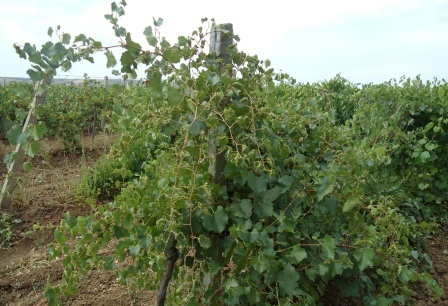


ArmInfo. The Armenian Ministry of Agriculture, with the support of the Food and Agriculture Organization of the United Nations (FAO), plans to implement a program in which seedlings of grapes resistant to phylloxera will be planted. This was reported by the Minister of Agriculture of Armenia Ignaty Arakelyan on October 11 at a meeting with journalists, summing up the results of the activity of the department headed by him in 2016-2017.
The minister did not announce the program budget, but noted that within the program, it will be possible to preserve both varieties of grapes endemic for Armenia, and imported ones.
In terms of development of winemaking, the Minister expressed satisfaction with the work of the Wine- growing and Winemaking Foundation of the Republic of Armenia, created by the government decision of June 23, 2016. The Fund's activities will be aimed at solving problems in connection with the issues of improving the quality of produced wine products in order to ensure its competitiveness in the domestic and foreign markets. According to the Minister, thanks to the activities of the Foundation, numerous events were held, participation of local companies in specialized international exhibitions was provided, where Armenian winemakers had already received numerous awards. "Already today we see an increase in the volume of wine sales, both in terms of exports and domestic sales," Arakelyan said.
Earlier, on August 18, at a meeting with journalists, the chairman of the Armenian National Wine Center Avag Harutyunyan stated that part of the Ararat valley and foothills had been declared an infected phylloxera. According to Harutyunyan, it is expected that because of this, a massive planting of European varieties of vineyards and the same mass destruction of contaminated vineyards will begin.
However, I think that there is much more, "said Avag Harutyunyan, chairman of the Armenian National Wine Center. At the same time, the expert expressed much greater concern not only about the size of the already infected territories, but also about the fact that the phylloxera continues to spread at a progressive pace.
In addition, during the Soviet era, the importation of new varieties of grapes to Ararat valley was banned, and after the collapse of the Union, the Armenian authorities did not take any action to control or prevent the spread of the disease. According to the National Statistical Service of Armenia, the volume of cognac produced in Armenia in January-August 2017 increased by 60.7% compared to the same period in 2017, amounting to 18.4 million liters. During the reporting period, wine production increased by 35.2%, amounting to 5.1 million liters, while vodka production decreased by 31.9% and amounted to 3.5 million liters. Champagne for the reported period was produced for 305 thousand liters against 253.9 thousand liters in January-August 2016, and beer - 15.7 million liters (an increase of 9.6%). At the same time, the production of whiskey for the reporting period amounted to 849.7 thousand liters (a decline of 17%). Production of non-alcoholic beverages amounted to 60.7 million liters, which is 31.4% more than in January-August 2016. According to the report of the Customs Service of Armenia, in 2016 Armenia exported 1.8 million liters of wine with an annual growth of 27.7%, with the customs value increasing by 43.6% to $ 5.9 million. In the first half of the year, wine exports increased by 61% to 1271.9 thousand liters, with the increase in customs value by 84.3% to $ 4.7mn.